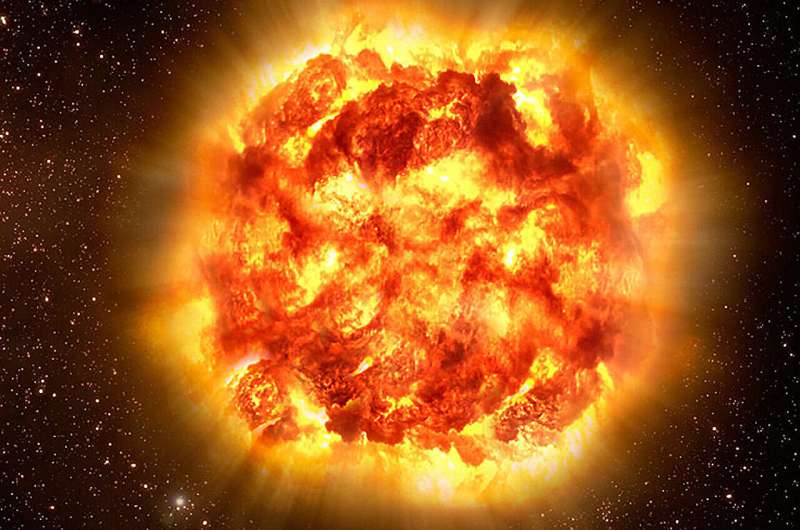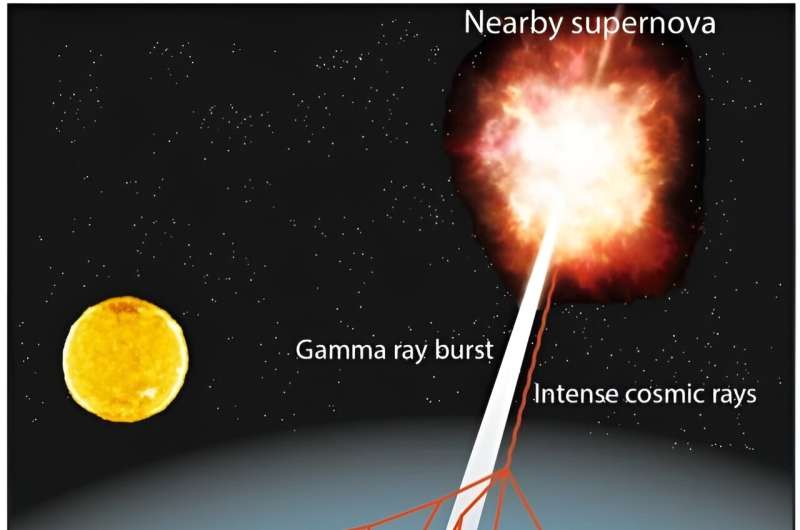Artist's impression of a Type II supernova explosion. These supernova produce gamma rays and powerful ionizing radiation that's hazardous to life. Credit: ESO
Earth's protective atmosphere has sheltered life for billions of years, creating a haven where evolution produced complex lifeforms like us. The ozone layer plays a critical role in shielding the biosphere from deadly UV radiation. It blocks 99% of the sun's powerful UV output. Earth's magnetosphere also shelters us.
But the sun is relatively tame. How effective are the ozone and the magnetosphere at protecting us from powerful supernova explosions?
Every million years—a small fraction of Earth's 4.5 billion-year lifetime—a massive star explodes within 100 parsecs (326 light-years) of Earth. We know this because our solar system sits inside a massive bubble in space called the Local Bubble.
It's a cavernous region of space where hydrogen density is much lower than outside the bubble. A series of supernovae explosions in the previous 10 to 20 million years carved out the bubble.
Supernovae are dangerous, and the closer a planet is to one, the more deadly its effects. Scientists have speculated on the effects that supernova explosions have had on Earth, wondering if they have triggered mass extinctions or at least partial extinctions.
A supernova's gamma-ray burst and cosmic rays can deplete Earth's ozone and allow ionizing UV radiation to reach the planet's surface. The effects can also create more aerosol particles in the atmosphere, increasing cloud coverage and causing global cooling.
A new research article published in Communications Earth & Environment examines supernova explosions and their effect on Earth. It is titled "Earth's atmosphere protects the biosphere from nearby supernovae." The lead author is Theodoros Christoudias from the Climate and Atmosphere Research Center, Cyprus Institute, Nicosia, Cyprus.
The Local Bubble isn't the only evidence of nearby core-collapse supernovae (SNe) in the last few million years. Ocean sediments also contain 60Fe, a radioactive isotope of iron with a half-life of 2.6 million years.
SNe expel 60Fe into space when they explode, indicating that a nearby supernova exploded about 2 million years ago. There's also 60Fe in sediments that indicate another SN explosion about 8 million years ago.
This graphic from the research article shows the potential atmospheric and climate impacts of a nearby supernova. Gamma rays can deplete the ozone, allowing more UV radiation to reach Earth’s surface. Some UV radiation is ionizing, meaning it can damage DNA. Cosmic rays can also create more condensation nuclei, meaning more clouds and potential global cooling. Credit: Communications Earth & Environment (2024). DOI: 10.1038/s43247-024-01490-9
Researchers have correlated an SN explosion with the Late Devonian extinction about 370 million years ago. In one paper, researchers found plant spores burned by UV light, an indication that something powerful depleted Earth's ozone layer. In fact, Earth's biodiversity declined for about 300,000 years prior to the Late Devonian extinction, suggesting that multiple SNe could've played a role.
Earth's ozone layer is in constant flux. As UV energy reaches it, it breaks ozone molecules (O3) apart. That dissipates the UV energy, and the oxygen atoms combine into O3 again. The cycle repeats.
That's a simplified version of the atmospheric chemistry involved, but it serves to illustrate the cycle. A nearby supernova could overwhelm the cycle, depleting the ozone column density and allowing more deadly UV to reach Earth's surface.
But in the new paper, Christoudias and his fellow authors suggest that Earth's ozone layer is much more resilient than thought and provides ample protection against SNe within 100 parsecs. While previous researchers have modeled Earth's atmosphere and its response to a nearby SN, the authors say that they've improved on that work.
More information: Theodoros Christoudias et al, Earth's atmosphere protects the biosphere from nearby supernovae, Communications Earth & Environment (2024). DOI: 10.1038/s43247-024-01490-9
Provided by Universe Today

























